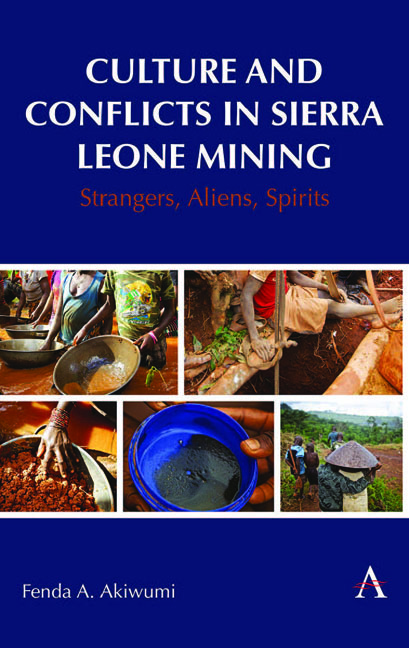Book contents
- Frontmatter
- Dediation
- Contents
- List of Figures and Tables
- Acknowledgements
- Abbreviations
- 1 Introduction: Culture in Commodity Chains
- 2 Sierra Leone’s Global Incorporation Through Mining
- 3 Cultural Difference: Policy and Legislative Dilemmas
- 4 Sacred Places: Local Ontology Meets Global Capital
- 5 Strangers, Environment, and Livelihoods
- 6 Race, Ethnicity, Class, and Gender in Mining
- 7 Between a Rock and a Hard Place
- 8 Conclusion
- References
- Index
6 - Race, Ethnicity, Class, and Gender in Mining
Published online by Cambridge University Press: 13 April 2024
- Frontmatter
- Dediation
- Contents
- List of Figures and Tables
- Acknowledgements
- Abbreviations
- 1 Introduction: Culture in Commodity Chains
- 2 Sierra Leone’s Global Incorporation Through Mining
- 3 Cultural Difference: Policy and Legislative Dilemmas
- 4 Sacred Places: Local Ontology Meets Global Capital
- 5 Strangers, Environment, and Livelihoods
- 6 Race, Ethnicity, Class, and Gender in Mining
- 7 Between a Rock and a Hard Place
- 8 Conclusion
- References
- Index
Summary
The mining company and the expatriate community represent an entirely different social world from that of Mogbwemo, but since they are involved in the same economic system, there is constant feedback between them.[…] Relationships between them, however, still basically revolve round superior-subordinate relations. (Labi 1972, 48)
In the colonial era, government geologists and mining engineers, and professionals and management at mining companies were predominantly Caucasian while Africans worked as laborers. The permanent mining enclave today is more racially and ethnically diverse, not a melting pot but rather a bubbling cauldron. Traditional structures wrestle with new hierarchical arrangements that support capital-intensive and technologically advanced extractive operations. Top management of foreign companies is typically expatriate, largely Caucasian, but today, including Chinese. Managers make up a small percentage of the workforce. Expatriate employees are hired under a different and higher salary scale than well-qualified Sierra Leonean or other African counterparts for equal or greater work. These spaces are plagued by issues like racial and class discrimination, ethnic strife, gender marginalization, and related unrest.
During the early years of mining in Sierra Leone, there was an influx of job seekers. An early photograph taken by Fowler-Lunn (1938, 128–129) in 1931 at Makong showed a six a.m. roll call with close to 300 people seeking employment as labor for the day. Figure 6.1 similarly shows labor outside the Sierra Rutile Plant Site seeking work in 2005. By 1963, Sierra Leone had the highest percentage of young men, out of the total male population giving up farming for mine employment compared to other West African mining economies. The SLDC employed about 5,000 men in 1931 at the iron ore mine at Marampa. When the Mining Wages Board of Sierra Leone introduced new wage policies in 1945 under the Wages Board Ordinance and as the company adopted labor-saving techniques, it gradually reduced its wage labor workforce. The numbers decreased from 4,195 in 1940 to 2,692 in 1960 and to 2,500 in 1975 (Clark 1966; Saylors 1967). This naturally affected workers now dependent on a new livelihood and their families. Tension occurred in mineworker households because the pay did not cover the many responsibilities.
- Type
- Chapter
- Information
- Culture and Conflicts in Sierra Leone MiningStrangers, Aliens, Spirits, pp. 97 - 110Publisher: Anthem PressPrint publication year: 2024



